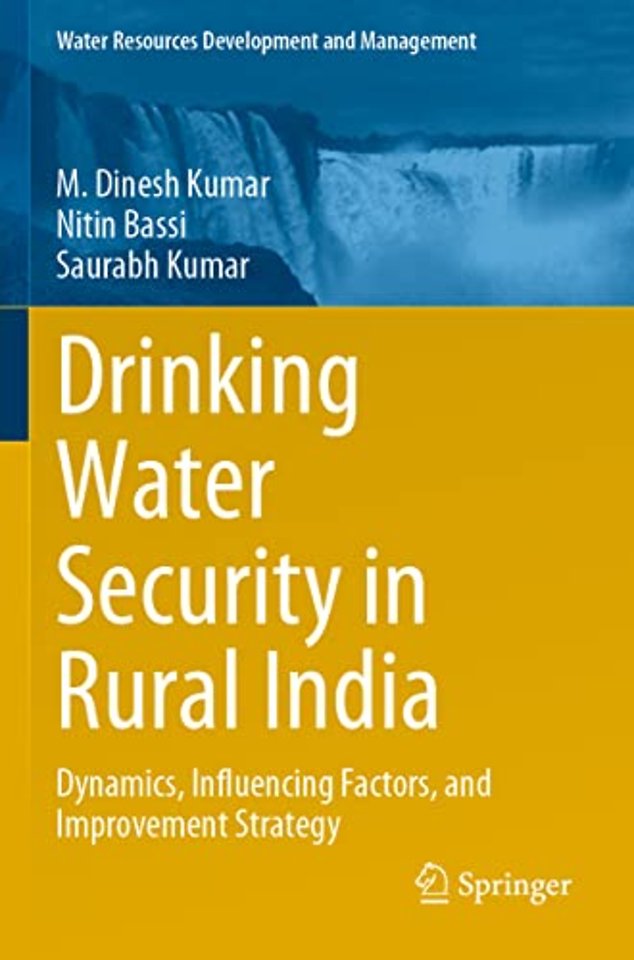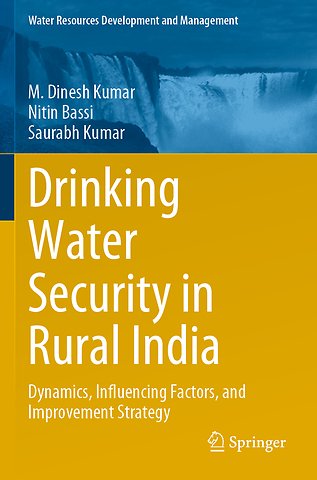Drinking Water Security in Rural India
Dynamics, Influencing Factors, and Improvement Strategy
Paperback Engels 2023 9789811692000Samenvatting
This book highlights the multi-pronged strategy for achieving sustainable rural domestic water supply in India. It deepens the understanding of groundwater (predominant source of water supply) behaviour in response to natural processes in different geological settings, analyses the factors influencing the performance of water supply schemes; identifies the conditions under which groundwater-based drinking water sources become sustainable, suggests measures for improving the sustainability of drinking water wells in hard rock regions (covering 2/3rd of India’s geographical area), presents a decision-making framework for planning rural water supply schemes in the country for ensuring long-term sustainability, and suggests physical strategies and policy measures for achieving them.
The analyses for development and validation of various models that explain groundwater system behaviour and performance of rural water supply schemes are undertaken for different geological settings in Maharashtra, as the state represents a microcosm of the various hydrological, topographical, and geohydrological conditions encountered in the country. The final analysis for proposing nation-wide strategies considers the various hydrological, geological, geohydrological, and topographical and climatic settings and groundwater contamination and pollution in the country.
Specificaties
Lezersrecensies
Inhoudsopgave
<p>Abstract</p>
<p>1.1 Introduction</p>
<p>1.2 Progress made by Indian States and Union Territories</p>
<p>1.3 Threats to Sustainability of Rural Domestic Water Supply</p>
<p>1.3.1 Technical sustainability of groundwater-based schemes</p>
<p>1.3.2 Financial sustainability of the schemes</p>
<p>1.3.3 Inequity in access to water</p>
<p>1.5 Objectives and Scope of the book</p>
<p>1.6 Contents of the Book and Chapter outline</p>
<p>References</p>
<p> </p>
<p>Chapter 2: Factors Influencing Groundwater Behaviour During Monsoon: Analysis from Maharashtra</p>
<p>Abstract</p>
<p>2.1 Introduction</p>
<p>2.2 Rainfall: Seasonality and other Features </p>
<p>2.3 Impact of Hydrological and Geohydrological Factors on Groundwater Behaviour</p>
<p>2.3.1 Rainfall and Water Level Fluctuation during Monsoon</p>
<p>2.3.2 Rainfall, Depth to Water Levels and Water Level Fluctuation</p>
<p>2.4 The Model Explaining Groundwater Behaviour during Monsoon</p>
<p>2.5 Findings </p>
<p>References</p>
<p> </p>
<p>Chapter 3: Factors Influencing the Performance of Rural Water Supply Schemes: Analysis from Maharashtra </p>
<p>Abstract</p>
<p>3.1 Introduction</p>
<p>3.2 Scheme Failure and Tanker water supply in Rural Areas</p>
<p>3.3 Influence of Irrigation Water Demand on Sustainability of Schemes: Theoretical Perspective</p>
<p>3.4 Impact of Gravity irrigation on Rural Water Supply Schemes: Theory and Empirical Evidence </p>
3.5 The Model Explaining the Varying Performance of Rural Water Supply Schemes<p></p>
<p>3.6 Factors Determining the Success of Groundwater-Based Schemes</p>
<p>3.7 Findings and Conclusions</p>
<p>References</p>
<p> </p>
<p>Chapter 4: Studying the Performance Review of the Rural Water Supply Schemes in Different Geological Settings</p>
<p>Abstract</p>
<p>4.1 Background</p>
<p>4.2 Selection of Water Supply Schemes</p>
<p>4.3 Scheme Characteristics and Respondents Details</p>
<p>4.4 Scheme Performance</p>
<p>4.4.1 Water Supply and Use</p>
4.4.2 Access to Water Supply<p></p>
<p>4.4.3 Frequency of Water Supply</p>
<p>4.4.4 Maintenance of Water Supply Scheme and Water Tax Recovery</p>
<p>4.5 Water Supply Improvement</p>
<p>4.6 Findings and Conclusions</p>
<p>References</p>
<p> </p>
<p>Chapter 5: Locating Water for Augmenting Rural Water Supply Schemes </p>
<p>Abstract</p>
<p>5.1 Introduction</p>
<p>5.2 Description of Selected Basins</p>
<p>5.3 Surface Water Availability in Selected River Basins</p>
<p>5.3.1 Water Utilisation by Minor Irrigation Schemes</p>
<p>5.3.2 Water Utilisation by Medium and Major Irrigation Schemes</p>
<p>5.3.3 Un-utilised Water Resource in the Basins</p>
<p>5.4 Scope for Augmenting the Rural Water Supply</p>
<p>5.5 Conclusion</p>
<p>References</p>
<p> </p>
<p>Chapter 6: Strategy for Improving Rural Domestic Water Supply: </p>
<p>Abstract</p>
<p>6.1 Current Discourse for Water Supply Augmentation</p>
<p>6.2 Suggested Technical-institutional Interventions for Improving Water Supply Scheme Sustainability </p>
<p>6.2.1 The Proposal </p>
6.2.2 Engineering Feasibility of Bulk Transfer of Water<p></p>
<p>6.2.3 Unit Cost of the Interventions</p>
<p>6.3 Scale of Investment Required for Improving Rural Water Supply</p>
<p>6.4 Conclusion</p>
<p>References</p>
<p> </p>
<p>Chapter 7: Towards Rural Drinking Water Security in India</p>
<p>Abstract</p>
<p>7.1 Introduction</p>
<p>7.2 A Decision-Making Framework for Planning Rural Water Supply</p>
<p>7.3 Strategies for Improving the Performance of Rural Water Supply Schemes</p>
<p>7.4 Implementing the Proposed Strategy </p>
<p>7.5 Policy Implications</p>
<p>References</p>
Rubrieken
- advisering
- algemeen management
- coaching en trainen
- communicatie en media
- economie
- financieel management
- inkoop en logistiek
- internet en social media
- it-management / ict
- juridisch
- leiderschap
- marketing
- mens en maatschappij
- non-profit
- ondernemen
- organisatiekunde
- personal finance
- personeelsmanagement
- persoonlijke effectiviteit
- projectmanagement
- psychologie
- reclame en verkoop
- strategisch management
- verandermanagement
- werk en loopbaan

